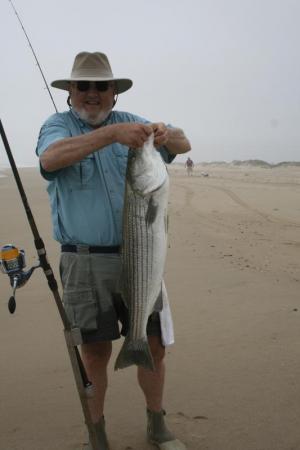It would appear that some very important people did not get surf-fishing permits for 2021. That has caused DNREC’s Division of Parks to put in motion a plan to issue 1,000 more permits. However, the plan is not set up at this time and will be announced at a future date.
We do know that in order to purchase a surf-fishing permit, you must first acquire a voucher on a day to be announced. These will be issued on a first-come, first-served basis. Each voucher is good for one surf-fishing permit, and they will not be sold online. Another person may pick up a voucher for you, but they must have all the information needed including the license plate number and registration name for the vehicle. Firefighters and EMTs must have a signed application form from their fire company when redeeming a voucher to obtain a 2021 surf-fishing permit. Residents and nonresidents may apply for a voucher. At the close of business on the day of voucher distribution, no more vouchers will be issued, even if all the vouchers are not claimed.
If you still miss out on a regular surf-fishing permit, you have a chance to get an off-peak surf-fishing permit. This is a pilot program that will begin in late May and will allow surf fishermen to drive on beaches during times when they are not crowded. This would be Mondays through Fridays from June 1 through Sept. 3. From Tuesday, Sept. 7 through Dec. 31, the off-peak permit will be good seven days a week. The cost of the off-peak permit is $70 for Delaware residents and $140 for nonresidents. Delaware residents 62 and older will receive a discounted rate of $60. Off-peak permits will be available at park offices and online once the program begins.
For more information, go to destateparks.com.
Spring surf
Back in the day, when many businesses shut down for Easter, that was the weekend when we would begin surf fishing. In those days, late ‘60s early ‘70s, we camped in a tent at the southside of Indian River Inlet. Since none of us had 4-wheel-drive vehicles yet, we walked on the beach and fished the South Pocket with bloodworms.
Then, as now, it wasn’t exactly a blitz. Being young and male, we all tried to out-cast each other. My brother-in-law at the time, Bobby Woods, was a good distance caster and I wasn’t all that bad. We figured the bigger fish would be in deeper water far from the beach. We were wrong.
A young boy with not much more than a freshwater outfit came up on the beach, cast his bloodworm just beyond the white water and hooked up right away. A tug of war commenced, and the boy finally dragged a 10-pound striper up on the sand. Bobby and I quickly shortened our casting distance, but that must have been the only fish there.
On another Easter weekend, we were once again drowning bloodworms at the South Pocket when we began catching the largest winter flounder I have even seen. These were all three- to four-pound fish, and the bite was pretty steady. I don’t remember exactly how many we caught, but it must have been five or six apiece before the bite shut off. I later found out those flounder are known as snowshoes.
Today, winter flounder of any size in Delaware are just a memory. Stripers are just as hard to find as they always were, so why do we continue to fish in the spring? Because that is what fishermen do!
Spring in the surf is a waiting game. The old saying, “Eight, bait and wait,” means just exactly that. You have to be there when the fish come past, and they run on their own schedule.
With today’s regulations, you have to release any striped bass between 37 and 44 inches, and the minimum size is 28 inches except during the summer in Delaware Bay when the slot limit is 20 to 25 inches between July 1 and Aug. 31. You must use circle hooks when fishing for them with bait. Please consider releasing all stripers until the population recovers.
What little success I have had with spring-run stripers has been on fresh bunker or bloodworms at Broadkill Beach or Herring Point. I like an east wind and an incoming tide with cloudy skies. The presence of bunker schools close to shore is an added bonus. I use a fish-finder rig and a circle hook. I have Tsunami free-spool spinning reels that allow the fish to run with the bait until I engage the drag, and the circle hook will set in the corner of the fish’s mouth.
See you on the beach!


























































